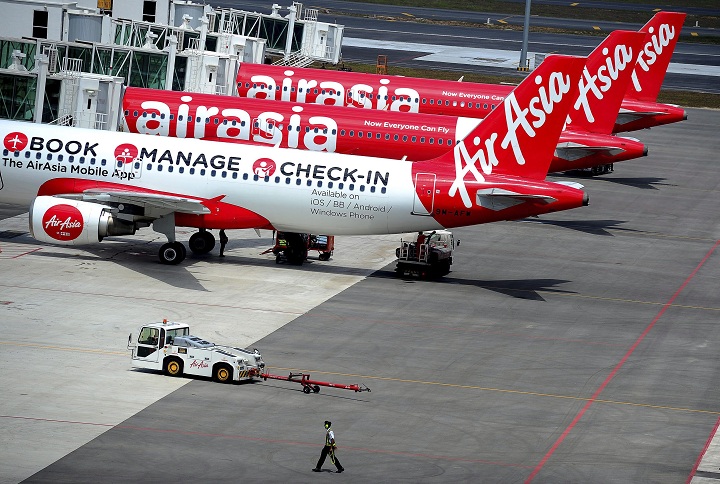PANGKALAN BUN, Indonesia – Highlighting the depth of Indonesia’s air safety problems, the transportation ministry announced harsh measures Monday against everyone who allowed AirAsia Flight 8501 to take off without proper permits – including the suspension of the airport’s operator and officials in the control tower.

The routing permits of all airlines flying in the country also will be examined to see if they are violating the rules, said Djoko Murjatmodjo, acting director general of air transportation.
“Who knows if other airlines are also doing the same thing,” he said.
The crackdown comes as searchers continue to fight bad weather while combing the Java Sea for bodies and wreckage of the Airbus A320 that crashed Dec. 28, killing all 162 passengers and crew on board.
The plane was travelling between Surabaya, Indonesia’s second-largest city, and Singapore on a Sunday. Officials have since said its permit for the popular route was only for Monday, Tuesday, Thursday and Saturday, and that AirAsia quietly switched three of those days. Officials in Singapore, however, have said the plane was authorized to fly on Sundays from its end.
READ MORE: Divers resume search for victims and fuselage of crashed AirAsia passenger jet
While the airline is being investigated, Indonesia announced Saturday that it banned all AirAsia flights between Surabaya and Singapore.
AirAsia Indonesia President Director Sunu Widyatmoko said by text Monday that the airline will co-operate with the government during the evaluation, but would not comment on the permit allegations until the process is complete.
Murjatmodjo said key individuals who allowed to plane to fly without permits would be suspended while the investigation is pending.
The ministry also issued a directive Dec. 31 ordering all airlines to provide pilots with up-to-date weather reports before they take off, he said. Currently, it’s up to the captain and co-pilot to research and evaluate flying conditions before departing. In other countries, carriers’ flight operations departments perform that task for them.
He also planned to meet Monday with the Corruption Eradication Commission to discuss whether to launch a graft probe into AirAsia’s operations. Business in the country is commonly conducted using bribery, with payoffs often seen as the most efficient way to get things done.
After Indonesia deregulated its aviation industry in the 1990s, dozens of airlines emerged making air travel affordable for the first time for many in the world’s fourth most populous nation. But a string of accidents in recent years has once again raised urgent questions about the safety of Indonesia’s booming airline sector, with experts saying poor maintenance, rule-bending, and a shortage of trained professionals are partly to blame.
AirAsia, which began operations in 2001 and quickly became one of the region’s leaders in low-cost air travel, has not experienced any other crashes and is widely considered a benchmark for safety and professionalism.
It is not known what caused Flight 8501 to crash into the Java Sea 42 minutes after taking off on what was supposed to be a two-hour flight. Just before losing contact, the pilot told air traffic control that he was approaching threatening clouds, but was denied permission to climb to a higher altitude because of heavy air traffic. No distress signal was issued.
While it remains unclear what caused the disaster, bad weather appears to have been a factor, according to a report by Indonesia’s Meteorology, Climatology and Geophysics Agency.
Since the plane’s disappearance, a massive international hunt has been underway. So far, 37 bodies have been recovered, including three more Monday, and sonar has identified five large pieces of what’s believed to be chunks of the fuselage on the ocean floor. Divers have tried to get a visual on the objects, but strong currents, silt and mud have kept them from reaching it.
So far, no signals have been heard from the cockpit voice and flight data recorders, or black boxes. Poor weather has prevented ships from dragging ping locators.
Antonius Tonny Budiono, of the Transportation Ministry, said efforts were again thwarted Monday due to towering waves.
As bodies have been flown back to Surabaya, one by one, many victims’ family members have struggled to deal with the slow process and fears that their loved ones may never be found.
On Monday, the relatives were offered a chance to visit the site where the plane crashed into the sea to say good-bye.
“I will facilitate the families of the victims who want to see the scene directly and how rescuers are battling high waves and bad weather to search for their loved ones and the plane,” said Gen. Moeldoko, Indonesia’s top military commander. “We’ll prepare two aircraft and a warship for them to go there and throw flowers.”
—
Associated Press writers Niniek Karmini, Ali Kotarumalos, Margie Mason and Robin McDowell in Jakarta, Indonesia, contributed to this report.

Comments